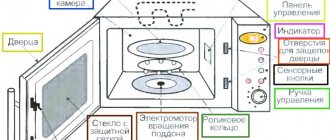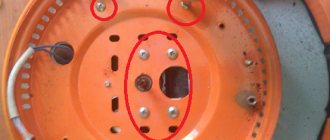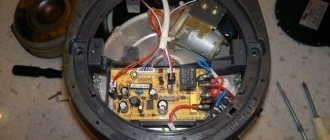Manufacturers Panasonic, Whirlpool, Daewoo, Samsung introduce unique options, but in general the problems and their causes are similar, as well as the principle of operation. The current passes to the transformer, where its voltage increases. A magnetron is activated, creating an electromagnetic field. It affects the liquid contained in the food, which causes heating. And if the microwave does not work, it is difficult to localize the fault, especially if you do not have enough experience.
Qualified repairs of microwave ovens are performed in a service center. Craftsmen repair products at home in the city of St. Petersburg. The service operates from 7:00 to 23:00 without weekends and holidays. During business hours, leave a request by phone, at any time - on the website by filling out a special form.
Why the microwave doesn’t work: it doesn’t heat food, or it doesn’t turn on at all
The device does not turn on or the microwave works but does not heat - what to do?
There can be several reasons for such a problem - from the simplest to quite complex. Sometimes it happens that the problem is completely different, and the owners are wrong to use the microwave oven. If such a situation arises, you need to start small. HELPFUL INFORMATION!
Many home craftsmen, deciding that they are already quite experienced, overestimate their strengths and, at the slightest malfunction, begin to look for the problem in the depths, while it lies on the surface. The result of such repairs may be complete failure of the microwave oven. After this, no specialist will undertake its restoration. Sometimes there is no need to even open the device for repairs - the solution may lie on the surface
Diagnosing microwave malfunctions
You can determine whether a microwave oven is truly hollow using the method of elimination. To do this, inspect the unit and check the functioning of the following elements:
- You need to start by checking the integrity of the power cord and outlet. If there is a break in the cord or an overloaded outlet, the microwave will not work. Here you should pay attention that the microwave oven is sensitive to the mains voltage. If the voltage is lower than 220 volts, the device does not work.
- The next step is to check the tightness of the door closure. Microwaves are dangerous to human health. And therefore the oven is designed in such a way that it can operate with the door tightly closed. If the lock on the door, the locking system or the closing element is broken, the microwave will not turn on.
- The last step is to check the fuse and thermal relay. The mains fuse may blow due to a sudden voltage drop in the network or a short circuit. If you replace the fuse, the device will work properly. The thermal relay turns off the operation of the device when the door is open. If the thermostat is not working properly, it needs to be replaced.
About repairing a microwave oven with your own hands in detail using the example of a Samsung oven
Let's start with the simplest faults that may arise during operation. You shouldn’t immediately run to the store for a new device or to a service center and take the device in for repair. Most problems can be fixed on your own.
Minor microwave malfunctions and how to fix them
Quite often, door latches fail. This can be avoided if you do not slam it or open it with a sharp jerk. Often malfunctions are the fault of the user himself. To repair, you will need to purchase a locking mechanism and replace it yourself.
HELPFUL INFORMATION!
Under no circumstances should you turn on a microwave oven with the door unlocked.
Modern models are automatically protected from this, but older models can turn on if you press the door with your hand, however, this is strictly prohibited. If there is any slightest malfunction of such a unit, you should immediately disconnect it from the network and begin repairs or seek help from specialists. The door should be opened and closed carefully, without unnecessary jerks or slams. If the Samsung microwave does not turn on, the cause of the “breakdown” may be a voltage drop in the main power supply.
It’s convenient if you have a multimeter at hand - you can measure the voltage in real time. If there is no such device, you can approximately determine the network parameters using a wire with a socket and an incandescent lamp - the voltage drop is clearly visible from the heating of the coil. However, be prepared for the fact that if the norm is greatly exceeded, the lamp will burn out or even burst. This situation, if it often occurs, can be corrected by installing a stabilizer at the input to the apartment or separately at the microwave outlet. This could be the voltage in the outlet - why be surprised that the microwave doesn’t work?
VERY IMPORTANT!
The microwave oven cannot be turned on empty. In the absence of a heating object, microwaves begin to reflect from the walls of the device. Sooner or later they will damage the magnetron. Repairing it is already quite difficult; it’s easier to buy a new one. This is what happens if you turn on the microwave empty.
Principle of operation
After connecting the microwave to the network, a voltage of 220V is supplied to the first winding of the transformer. Automatically the voltage is transferred to the secondary winding. The chamber heating system starts. Due to the fact that these two windings are isolated from each other, safe operation of the microwave oven is ensured. A microwave oven allows you to heat food at high speeds by using double the voltage. In this circuit, the main role is played by a capacitor, to which a diode is connected in parallel. The duration and magnitude of the temperature regime helps to control the temperature sensor and a regular timer. For safe use, the oven has a built-in power protection relay, the function of which is to stop the operation of the microwave in the event of high voltage drops in the network or when the door is open. If all this description seems complicated to you, then don’t worry: we’ll figure it out now.
Do-it-yourself microwave oven repair for more serious problems
There may be several reasons why the microwave has stopped heating. Most often these are problems:
- control unit (timer malfunction);
- power network;
- fuse (a sudden surge in voltage can damage it);
- capacitor;
- high voltage diode;
- magnetron (the most expensive part of a microwave oven).
Now let’s try to figure out in detail how it is possible to eliminate such breakdowns - how to fix a microwave oven with your own hands. Repairing a microwave oven with your own hands is possible, but requires care and precision
Do-it-yourself microwave oven repair if the control unit fails and the timer malfunctions
First, unplug the microwave oven, unscrew the screws on the back, and remove the protective cover. Next, we carefully inspect the control board for burnout of conductive paths, swelling, and burnout of elements. It happens that a microwave begins to take on a life of its own – it can spontaneously turn on, turn off, or refuse to work.
Here the problem may be a faulty touchpad. In any case, although such parts can be restored, they will not work for long. It is much more cost-effective to purchase a new unit or keyboard, installing them in place of the old ones.
IMPORTANT!
When purchasing replacement parts, choose those marked with the same markings as those previously installed. This way you will save yourself from unnecessary costs. By the way, such purchases cannot be returned or exchanged. Repair of the control unit - soldering of jumpers to replace burnt tracks
The microwave works, but stopped heating due to problems in the power circuit
This happens quite often. The first step is to check the magnetron circuit fuse (high voltage). If it burns out, the backlight of the microwave oven and the rotation of the platform remain in working order, and power is not supplied to the magnetron (microwave gun). This can be treated by replacing the high-voltage fuse. This is what a high-voltage fuse looks like in a protective casing
Why does the microwave work but does not heat food: checking the capacitors
The microwave oven circuit contains a multiplier capacitor as well as pass capacitors. All of them should be checked using an ohmmeter (the multimeter also has such a function). They can be the reason why the microwave turns but does not heat. If faulty ones are found, they should be replaced. It makes sense to check the high voltage diode. If it does not “ring” in either direction, you need to replace it. High voltage diode - if it does not ring, it should be changed
The microwave oven works, but does not heat: we are looking for the reason in the magnetron
The main and most expensive part of a microwave oven is the magnetron. If all of the above problems are not confirmed, then the problem is more serious than initially thought. Most often, the filament burns out, which can be checked by measuring the resistance.
If there is no resistance, then concerns about unnecessary costs are confirmed. This will be the reason that the microwave works, but does not heat. There is no point in repairing the magnetron - the work is quite labor-intensive. It's easier to buy a new one.
Magnetron is the most expensive part of a microwave oven
IMPORTANT!
Before purchasing, copy down the data of the old magnetron and its markings. It is better to take the burnt part with you along with the rewritten markings for comparison.
Magnetron malfunction
If the backlight works in the oven, the plate rotates, but the microwave does not heat the food, then most likely the cause of the malfunction is a malfunction of the magnetron. In the above diagram, the magnetron is designated as “magnetron”. A magnetron is a device that generates microwave radiation. That is why if this part fails, the oven does not heat.
The magnetron is housed in a small rectangular metal housing. First you need to clean it and then carry out a visual inspection. Next, inspect the magnetron unit itself. Namely, the integrity of the wires connecting the terminals and the housing. Often the reason the magnetron does not work is the failure of the feed-through capacitor. Below watch the video on how to repair a microwave oven magnetron with your own hands:
After this, be sure to check the microwave control unit. Again, pay attention to burnt, sooty and dirty areas. It is these parts that will need to be replaced for the microwave to continue operating.
Why does a microwave oven spark during operation: reasons, solutions
Most often, the cause of such a malfunction is user inattention. Turning on a device with an empty platform, metal objects in a working device, drops of dried fat on a mica plate - this is what can cause such a nuisance.
Even utensils with gold or silver rims cannot be used for microwave heating, let alone stainless steel or enameled steel utensils. Let's look at the causes of sparks and methods for eliminating them.
Microwave oven malfunctions causing cracking noises and sparks
A mica plate, if it is not promptly cleaned of any grease that has fallen on it, begins to deteriorate over time. This happens due to the heating of food debris accumulated on it. As a result, a small black speck appears on the mica plate (microwave diffuser), which quickly grows during operation of the microwave oven. The process is accompanied by smoke, sparks, and crackling sounds. Consequences of burning a mica plate (microwave diffuser)
Crackling and sparks inside the microwave: what to do, how to troubleshoot
The first step is to thoroughly clean the inside of the microwave oven. To replace it, it is better to purchase a larger plate. Having attached the old one to it, we cut out the required shape with ordinary scissors, and sand the edges with sandpaper. Next, we mark and drill holes for the mounting screws, after which all that remains is to fix the cut plate with self-tapping screws. Mark the outline of the old plate with a pencil and cut out a new one
IMPORTANT INFORMATION! After removing the mica plate, pay attention to the condition of the magnetron cap. If necessary, it should also be replaced. Another cause of crackling and sparks can be peeling of the camera enamel. This happens when too large dishes are placed in the oven to heat up. It rubs against the walls, leaving scratches that lead to sparks and can easily damage the magnetron. If scratches appear, perform the following actions.
- Thoroughly wash the chamber to remove dried fat.
- Clean the scratches with sandpaper and degrease.
- We apply a primer, and then 2-3 layers of enamel (food grade, fireproof or electrically conductive).
- We wait for it to dry completely, after which the device can be used.
This kind of microwave oven cannot be used - it requires restoration and replacement of the mica plate, which is already starting to burn out.
Why do microwave ovens break down?
It is believed that a microwave oven is a fairly reliable unit that rarely fails. And most often, the reasons for its breakdown are improper operation and wear of parts during long-term use of the device. So why might a microwave break?
- When heating, utensils that are not suitable for microwave use are used. Only glass or plastic containers can be used in the SChV. The container lid must be open. When heating with a tightly closed lid, the cookware may explode, which will damage the inner chamber and parts of the stove.
- There is a metal object in the microwave while it is running. Often, users leave cutlery in dishes, which can lead to sparking, cracking and puncture on the inner surface of the chamber. The same consequences will result from using metal utensils or utensils with foil patterns applied to them.
- When heating food, a special plastic cap is not used. It protects the chamber walls and internal elements from contamination by drops of liquid and fat that evaporate from the surface of the dish when heated.
Other possible malfunctions: causes, solutions
It happens that heating is produced, the light inside the chamber lights up, but the platform does not rotate. The reasons for this may be:
- incorrect installation of the plate;
- broken drive gears;
- engine failure;
- bad contacts.
The problem with the plate is easily solved - you just need to fix it. If this is not the reason, you will have to disassemble the device. Failure of gear gears is a problem that occurs more often in new models of microwave ovens.
In pursuit of reducing the cost of the product, the manufacturer began installing short-lived plastic gears (older models had metal ones). If this is the reason, then the sore is treated by replacing the gearbox - restoring the gear teeth is unrealistic. The plate must fit neatly into the grooves. The gear motor that rotates the tray may fail under the influence of power surges. In this case, one of the stator windings burns out. The result is motor failure.
Previously, engines could be sent in for repairs. They were rewound and they could function again. Today, such workshops no longer exist: in the event of such a breakdown, you will have to buy and install a new one. The main thing is to clearly and correctly rewrite the markings. Otherwise, the engine simply will not fit your model. The solution to the problem of bad contacts is quite simple. All connections must be cleaned of oxide, if necessary, tightened and connected in the reverse order.
What to do if the microwave oven does not turn on at all
If the microwave does not turn on, the reasons should be sought in the 220 V socket, plug, wire or fuse. The socket is checked, the wire and fuse are checked using a multimeter. The faulty part is replaced with a new one. If you think about it, this is the simplest problem that can happen to your microwave oven. A blown microwave oven fuse needs to be replaced.
Why do microwave ovens break down?
It is believed that a microwave oven is a fairly reliable unit that rarely fails. And most often, the reasons for its breakdown are improper operation and wear of parts during long-term use of the device. So why might a microwave break?
- When heating, utensils that are not suitable for microwave use are used. Only glass or plastic containers can be used in the SChV. The container lid must be open. When heating with a tightly closed lid, the cookware may explode, which will damage the inner chamber and parts of the stove.
- There is a metal object in the microwave while it is running. Often, users leave cutlery in dishes, which can lead to sparking, cracking and puncture on the inner surface of the chamber. The same consequences will result from using metal utensils or utensils with foil patterns applied to them.
- When heating food, a special plastic cap is not used. It protects the chamber walls and internal elements from contamination by drops of liquid and fat that evaporate from the surface of the dish when heated.
Let's sum it up
A microwave oven is a necessary household appliance for any home. But to ensure it works smoothly and your food doesn’t stay cold, you need to keep an eye on it. It is better to wipe off any drops of fat that fall on the walls of the chamber immediately, and do a full wash at least once a week. This will prevent burnout of the mica plate, as well as failure of the magnetron.
Plates with a silver or gold pattern are direct damage to the equipment, this should also be remembered. The dishes should match the size of the rotating tray or be slightly smaller - this will protect against scratches on the walls of the chamber. By following these simple rules, you will extend the life of your microwave oven for many years.
Take care of your equipment - this will extend its service life for many years. We hope that the information presented in today's article was useful to our dear reader. Despite the fact that we tried to present it in the most accessible way, perhaps some of you still have unclear points or have questions while reading. Describe the point in the discussions below.
Our editorial team will try to answer all questions and clarify unclear points as quickly and thoroughly as possible. Have you ever had a problem with your microwave that you solved on your own? Write about it - such experience will be useful for beginning home craftsmen. Ask, communicate, share opinions. And finally, we suggest watching a video about repairing microwave ovens with your own hands.
Signs of a microwave oven breakdown
Most often, external signs of a microwave oven malfunctioning are the appearance of sparks, puffs of smoke, the plate stopping from rotating, and the lack of heating of food placed in the oven. Or the microwave simply won’t turn on. In this case, it is dangerous to plug it into the network! There are three main reasons for electrical appliance failure:
- Fuses blown;
- Magnetron malfunction;
- Burnout of the mica plate.
In case of this type of breakdown, you can repair the stove if you follow the instructions strictly. First, consider the functional diagram of a microwave oven. We take the functional diagram because It makes it easier to understand the operating principle of a microwave oven, it is universal, regardless of the brand of the oven, it is simpler compared to the circuit diagram of a microwave oven.
And the location of the microwave elements can be seen in this figure:
Repair depending on breakdown
If the fuse is broken, you won't be able to find out without removing the back cover. The light in the camera that goes out will tell you that the mains fuse has blown. Did the wire survive? Get out the ohmmeter and do a serious check. The same tool is useful for examining the high-voltage fuse (hidden under the casing). Even a small resistance indicates a false alarm - the breakdown will have to be looked for elsewhere. If the fuse is blown, it must be replaced.
The multiplier deserves special attention - this part consists of a capacitor and a diode. You can use an ohmmeter for this. A sure sign of a faulty multiplier is the buzzing of the microwave when there is no heating. You won’t be able to check the diode yourself - it’s better to change it right away (it costs pennies). Now - feed-through capacitors. You should look for these spare parts inside the high-frequency lamp. If you want to make sure that the Samsung microwave does not heat up for this reason, proceed as follows:
- Discharge the capacitors.
- Test each part with an ohmmeter.
- Make sure that the device displays a value of 0.1 Ohm (functional).
- A zero parameter indicates a breakdown.
- Replace the unusable part.
The microwave may also hum due to a malfunction of the magnetron. The filament is checked with an already familiar tool - an ohmmeter. The normal resistance parameter is two to three ohms.
Device and principle of operation
We will look at this issue superficially so as not to deviate from the main topic. The information will be simplified as much as possible, since not all home craftsmen have deep knowledge of electrical engineering. Let's start with a description and purpose of the main structural elements, they are presented below in the figure.
Rice. 1. Microwave device
Designations:
- Door latches serve both to secure the door and to lock the door in the open position.
- A rotating tray on which dielectric cookware is placed.
- A separator equipped with rollers that drives the pallet.
- Drive rotating the separator.
- The backlight turns on depending on the operating mode.
- Ventilation (usually forced).
- A magnetron is a microwave radiation generator; in fact, it is the main structural element. You can find out how it works and the principle of its operation by reading the article on our website dedicated to this issue.
- The waveguide ensures the movement of microwave waves to the microwave chamber. It is a hollow metal pipe of rectangular cross-section.
- High voltage diode.
- Capacitor.
- Waveguide power supply circuit transformer and control circuit.
- Control block.
We will not provide a complete schematic diagram of the device, since they can differ greatly in different models of microwave ovens. In our case, the magnetron power circuit will be sufficient. As a rule, it has a standard structure.
Typical magnetron power circuit diagram
Let us briefly describe the operating principle of the above circuit. Power to the primary winding of the transformer (I) comes from an external control circuit that regulates the power and duration of microwave radiation. One of the secondary windings (II) supplies voltage to the magnetron filament. Winding II is made of 2-4 turns of thick wire, since the current in the filament circuit can reach 10.0 A at a voltage of about 3 volts.
Another secondary winding (III), which supplies a high voltage level (up to 3.0 kV), is usually called anode. As can be seen from the figure, in this circuit, a rectifier and voltage multiplier are built on the basis of a high-voltage diode (VD1) and a capacitor (C1). In this case, VD1 is turned on so that the opening occurs at a positive half-cycle, as a result the capacitor begins to charge. When the negative half-cycle begins, diode VD1 closes and voltage is supplied to magnetron M1 together with the charge accumulated on the capacitor. This leads to a doubling of the voltage and the formation of an electric field of the required intensity in the magnetron.
Resistance R1 in this case is necessary for discharge C1. Typically, this resistor is located in the capacitor housing. As for VD2, it provides protection in the event of an increase in voltage across capacitor C1 or a short circuit occurs in magnetron M1.
Diagnosing microwave malfunctions
You can determine whether a microwave oven is truly hollow using the method of elimination. To do this, inspect the unit and check the functioning of the following elements:
- You need to start by checking the integrity of the power cord and outlet. If there is a break in the cord or an overloaded outlet, the microwave will not work. Here you should pay attention that the microwave oven is sensitive to the mains voltage. If the voltage is lower than 220 volts, the device does not work.
- The next step is to check the tightness of the door closure. Microwaves are dangerous to human health. And therefore the oven is designed in such a way that it can operate with the door tightly closed. If the lock on the door, the locking system or the closing element is broken, the microwave will not turn on.
- The last step is to check the fuse and thermal relay. The mains fuse may blow due to a sudden voltage drop in the network or a short circuit. If you replace the fuse, the device will work properly. The thermal relay turns off the operation of the device when the door is open. If the thermostat is not working properly, it needs to be replaced.











